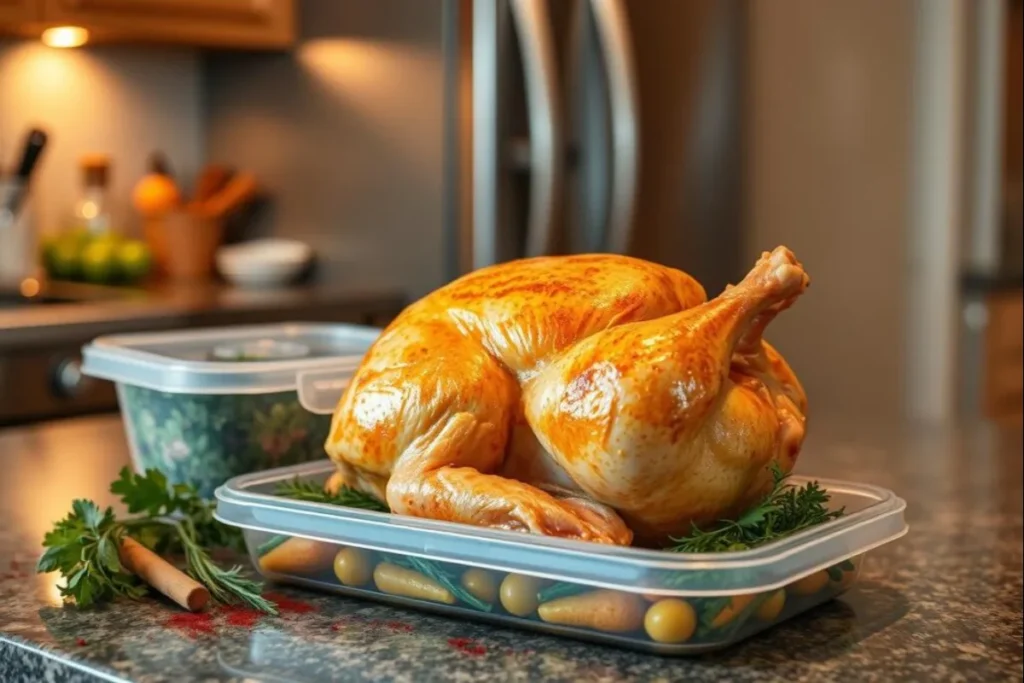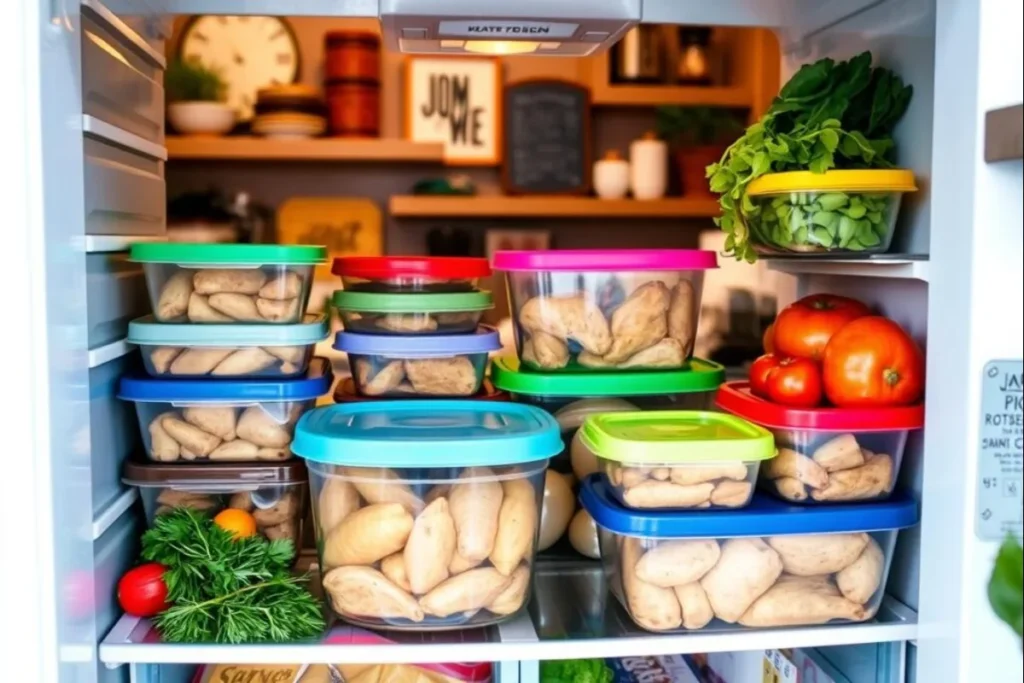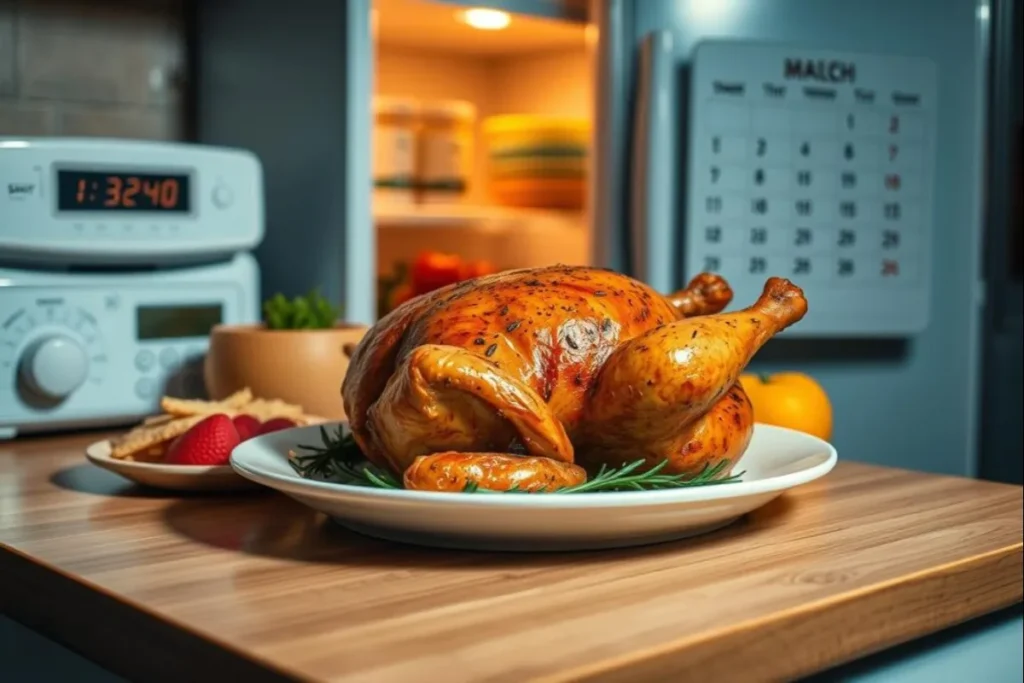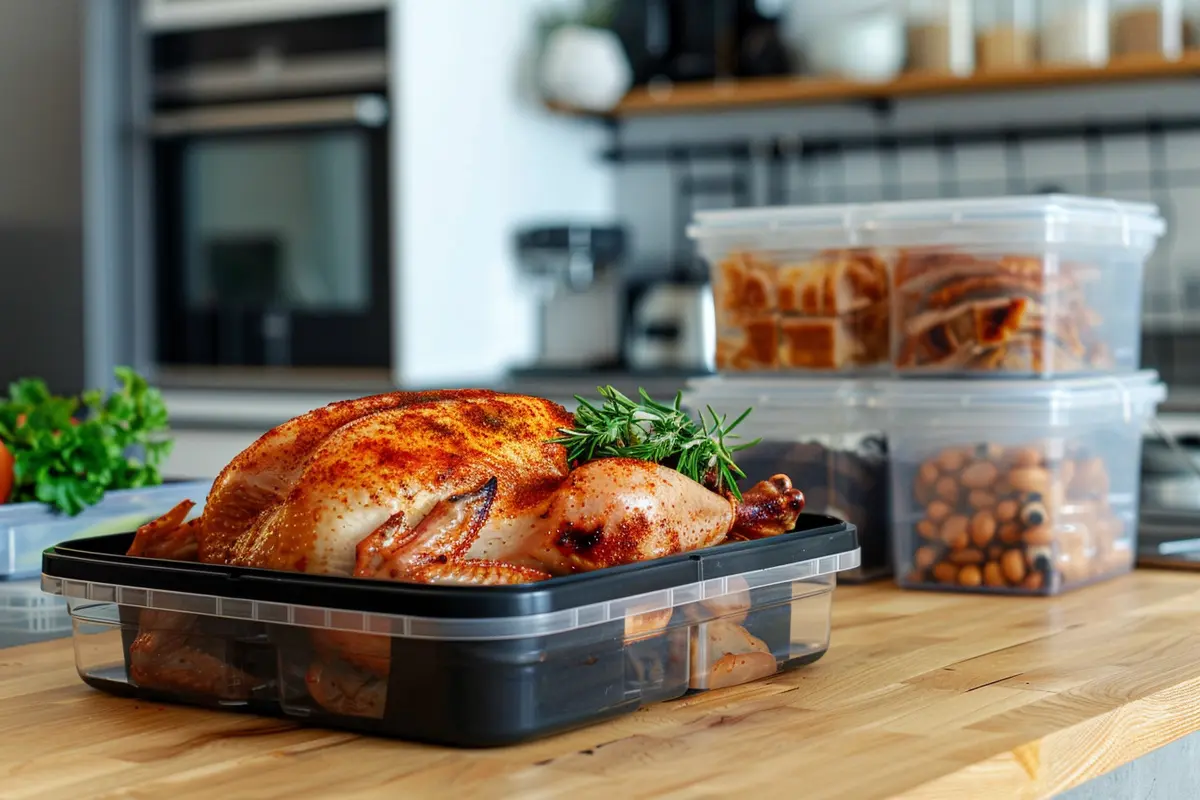Storing leftover rotisserie chicken right is key to keeping it tasty and safe. Knowing about food safety is important to avoid getting sick from eating it. It’s crucial to think about how to store leftover chicken safely to enjoy a healthy meal.

By storing your chicken correctly, you can make it last longer and stay safe to eat. In this article, we’ll dive into the details of storing rotisserie chicken and keeping it safe. This will help you enjoy your chicken with peace of mind.
Key Takeaways
- Proper storage is essential for maintaining the quality and safety of leftover chicken
- Rotisserie chicken storage and leftover chicken safety are critical considerations
- Following proper storage guidelines can extend the shelf life of leftover chicken
- Understanding food safety basics can reduce the risk of foodborne illness
- Proper storage and handling can ensure a healthy and delicious meal
Understanding Rotisserie Chicken Storage Basics
To keep your rotisserie chicken fresh and safe, knowing how to store it is key. First, cool the chicken quickly to a safe temperature. This step is crucial for keeping it fresh and preventing bacteria from growing.
For storing rotisserie chicken, following some important tips can help a lot. Keeping the chicken at or below 40°F (4°C) is essential. This temperature slows down bacteria, letting you enjoy your chicken longer.
Optimal Storage Temperature
To keep rotisserie chicken safe, store it at or below 40°F (4°C). Cooling the chicken quickly after use prevents bacterial growth. Use shallow, airtight containers for efficient cooling.
For more tips on maintaining chicken freshness, explore Chicken Recipes Justalittlebite, which offers insights into using chicken creatively.
Initial Cooling Process
Cooling the chicken quickly is important. Place it in a shallow container and refrigerate it right away.
Container Selection Tips
Choosing the right container is important for storing rotisserie chicken. Use airtight, shallow containers for efficient cooling and to prevent moisture buildup. By following these tips and keeping the chicken at the right temperature, you can enjoy it longer while keeping it safe and fresh.

How Long is Leftover Rotisserie Chicken Good in the Fridge?
Storing leftover rotisserie chicken right is key. Knowing how to keep it fresh is important. It’s all about the right storage and handling.
To keep the chicken fresh, follow some easy steps. Store it in a covered, airtight container. Keep it at a fridge temperature of 40°F (4°C) or below.
Factors Affecting Shelf Life
- Storage temperature
- Handling practices
- Container type and quality
Average Shelf Life
Cooked chicken can last 3 to 4 days in the fridge. But, this can change based on storage and handling. Always check the chicken for spoilage signs before eating.

Signs of Freshness
Check for spoilage signs like bad smell, slimy feel, or mold. If it looks and smells good, it’s probably safe. Always be careful with leftover chicken and throw it away if unsure.
| Storage Method | Shelf Life |
|---|---|
| Refrigeration | 3-4 days |
| Freezing | 4-6 months |
Signs Your Leftover Chicken Has Gone Bad
Spoiled chicken can show signs like:
- Slimy texture or sticky surface
- A sour, ammonia-like smell
- Mold or discoloration
When in doubt, discard the chicken. For ideas on handling leftover tough chicken, visit What to Do with Leftover Tough Chicken.
Visual Indicators of Spoilage
- Mold or greenish patches on the surface
- Slime or a sticky texture
- An off-color or grayish appearance
Smell Test Guidelines
A strong, bad smell means the chicken is spoiled. Sour, ammonia-like, or very strong smells are warning signs. It’s best to discard the chicken if you notice these smells.
Texture Changes to Watch For
Texture changes can also show spoilage. Soft, mushy, or sticky chicken is likely bad. Always trust your instincts and discard chicken if unsure for food safety.
Best Practices for Storing Rotisserie Chicken
Storing rotisserie chicken safely is crucial. Use airtight containers to keep it fresh. Label the containers with the date and what’s inside. Always store them in a cool fridge.
Here are some key tips to keep your chicken fresh and safe:
- Store the chicken in a sealed container to keep out moisture and contaminants.
- Keep the chicken in the fridge at a temperature below 40°F (4°C).
- Eat the chicken within a few days, or freeze it for later.
By following these steps, you can enjoy your rotisserie chicken safely. Always check the chicken for spoilage before eating. If unsure, throw it away.
Proper Packaging Methods for Maximum Freshness
Storing leftover rotisserie chicken right is key to keeping it fresh. Using food storage tips helps extend its chicken fridge life. Airtight containers are great because they keep moisture and contaminants out.
Choose from glass or plastic containers with tight lids. You can also use zip-top bags or aluminum foil. Make sure to remove air before sealing. Portioning the chicken helps prevent contamination and makes reheating simpler.
- Use airtight containers to prevent moisture and contaminants
- Wrap the chicken tightly in plastic wrap or aluminum foil
- Portion the chicken into smaller amounts for easier storage and reheating
By using these food storage tips and the right packaging, you can keep your chicken fresh. This way, your leftover rotisserie chicken stays safe and tasty longer.
| Packaging Method | Effectiveness | Ease of Use |
|---|---|---|
| Airtight Containers | High | Easy |
| Zip-top Bags | Medium | Easy |
| Aluminum Foil | Low | Medium |
Temperature Danger Zone and Food Safety
Understanding the temperature danger zone is key for chicken safety. Bacteria grow fast in the 40°F to 140°F range. So, it’s important to keep chicken out of this zone when storing and reheating.
To keep chicken safe, store cooked chicken in a sealed container below 40°F. When reheating, make sure it reaches 165°F. Here are some tips:
- Always use a food thermometer to check the internal temperature of the chicken.
- Reheat chicken to an internal temperature of at least 165°F.
- Store cooked chicken in a sealed container at a temperature below 40°F.
By following these tips, you can prevent foodborne illness and ensure chicken safety. Always be cautious with food safety.
Tips for Extending Your Chicken’s Shelf Life
To keep your rotisserie chicken fresh, using the right rotisserie chicken storage methods is key. Good storage can make your chicken last longer, so you can enjoy it for more days.
For a longer-lasting chicken, it’s important to store it right away. Cool it down and put it in a sealed container. Here are some tips to help you:
Immediate Storage Techniques
- Let the chicken rest for 30 minutes to 1 hour before refrigerating or freezing.
- Use a food thermometer to ensure the chicken has reached a safe internal temperature of 165°F (74°C).
- Store the chicken in a covered, airtight container to prevent moisture and other contaminants from affecting the chicken shelf life.
Organization Methods
To avoid eating old chicken, organize your fridge well. Label containers with the date and arrange them so the oldest is eaten first. These rotisserie chicken storage tips will help your chicken stay fresh longer, making every meal delicious.
Freezing Leftover Rotisserie Chicken
Freezing is a great way to keep leftover chicken fresh for longer. It helps keep the chicken safe and tasty. When you freeze leftover rotisserie chicken, following the right steps is key.
Freezing Guidelines
First, cool the chicken to a safe temperature within two hours of cooking. Then, put it in airtight containers or freezer bags. This stops bacteria from growing. Always label the containers with the date and what’s inside, and keep them in the freezer at 0°F (-18°C) or below.
Thawing Methods
When you’re ready to use the chicken, thaw it safely. You can thaw it in the fridge, in cold water, or in the microwave. Always wash your hands before and after touching the chicken. Cook it to 165°F (74°C) to keep it safe.
Quality After Freezing
The quality of frozen chicken depends on how it’s stored and handled. Frozen chicken can stay good for months without losing much taste or texture. But, it’s important to store it correctly to keep it safe and tasty.
By following these tips, you can enjoy your leftover rotisserie chicken safely. Always handle and store the chicken right to avoid foodborne illnesses.
Reheating Safety Guidelines
When reheating chicken, food safety is crucial. It’s important to heat chicken to a safe temperature to avoid illness. Always use a thermometer to check the chicken’s internal temperature.
When reheating chicken:
- Heat to an internal temperature of 165°F (74°C).
- Use a food thermometer to check the temperature.
- Avoid reheating multiple times to prevent bacterial growth.
Explore additional reheating techniques in How to Cook Chicken Very Tender for perfect texture.s.
It’s also important to handle and store reheated chicken properly. This includes storing it in a sealed container and keeping it refrigerated at 40°F (4°C) or below. This helps prevent cross-contamination and keeps food safe.
| Reheating Method | Internal Temperature | Food Safety |
|---|---|---|
| Oven | 165°F (74°C) | Safe |
| Stovetop | 165°F (74°C) | Safe |
| Microwave | 165°F (74°C) | Safe |
Creative Ways to Use Leftover Rotisserie Chicken
Leftover rotisserie chicken is a treasure trove of culinary possibilities. With a little creativity, yesterday’s dinner can become a brand new meal. Whether you’re craving something quick or something more elaborate, there are countless chicken recipes to try.
When cooking chicken, think outside the box. Use leftover chicken in salads, soups, or sandwiches. Get inspired by international cuisines like Mexican or Asian dishes. The possibilities are endless, and with a little experimentation, you can find new favorite chicken recipes.
Quick Meal Ideas
- Chicken salad with mixed greens and your favorite toppings
- Chicken soup with noodles or rice
- Chicken tacos with salsa and avocado
Recipe Suggestions
For a more elaborate meal, try making chicken pot pie or chicken enchiladas. You can also make a delicious chicken stir-fry or chicken fried rice. The key is to have fun and be creative with your cooking chicken experiments.
With a little imagination, leftover rotisserie chicken can become a culinary masterpiece. So next time you’re wondering what to do with last night’s dinner, remember that the possibilities are endless. The world of chicken recipes is waiting to be explored.
| Recipe | Ingredients | Cooking Time |
|---|---|---|
| Chicken Salad | Chicken, mixed greens, veggies | 10 minutes |
| Chicken Soup | Chicken, noodles, veggies | 30 minutes |
| Chicken Tacos | Chicken, tortillas, salsa, avocado | 20 minutes |
When to Trust Your Instincts About Food Safety
When it comes to food safety, trusting your instincts is key. If chicken looks, smells, or tastes off, it’s best to throw it away. This is crucial for chicken safety because bad chicken can make you sick.
Here are some signs that may indicate your chicken has gone bad:
- Slime or mold on the surface
- A strong, unpleasant smell
- A slimy or soft texture
Remember, food safety is very important. It’s always better to be safe than sorry. If you’re not sure if your chicken is good, it’s best to throw it away and cook fresh chicken. Your health is worth it.
By being careful with chicken safety and trusting your instincts, you can enjoy your meals safely. Always put food safety first and handle your chicken with care.
Conclusion
Storing leftover rotisserie chicken right is key to keeping it fresh and safe. By following the tips in this article, you can enjoy your chicken for longer. This way, you avoid foodborne illnesses.
Act fast, store it correctly, and always check its condition. A little care can make your leftover chicken taste great again. You’ll get more out of your meal.
Next time you have leftover chicken, use these tips. You’ll enjoy your meal more and keep your family safe and healthy.
FAQ
How Long is Leftover Rotisserie Chicken Good in the Fridge?
Leftover rotisserie chicken can stay fresh for 3-4 days in the fridge. It’s crucial to cool it down quickly and store it in airtight containers. This keeps it fresh and safe to eat.
What is the Optimal Storage Temperature for Leftover Rotisserie Chicken?
The best fridge temperature for leftover chicken is 40°F or lower. This slows down bacteria growth and prevents illness.
What are the Signs that Leftover Rotisserie Chicken Has Gone Bad?
Bad chicken shows as a slimy texture, an off smell, or mold. If it smells bad or looks off, throw it away.
What are the Best Practices for Storing Rotisserie Chicken?
For storing chicken, cool it down fast to 40°F or below. Store it in airtight containers or wrap it tightly. Label the containers with the date. Keep it in the coldest fridge part. Use it within 3-4 days.
Can Leftover Rotisserie Chicken Be Frozen?
Yes, you can freeze leftover chicken to keep it longer. Freeze it in airtight containers or bags for up to 3-4 months. Thaw it in the fridge before reheating.
What is the Proper Way to Reheat Leftover Rotisserie Chicken?
Reheat chicken safely in the oven, on the stovetop, or in the microwave. Heat it to 165°F. Don’t let it sit at room temperature for too long to prevent bacteria growth.
What are Some Creative Ways to Use Leftover Rotisserie Chicken?
Use leftover chicken in many tasty ways. Add it to salads, wraps, or sandwiches. Use it in soups, casseroles, or fried rice. Mix it into pasta or make chicken salad. Shred it for pizza or baked potato toppings.

